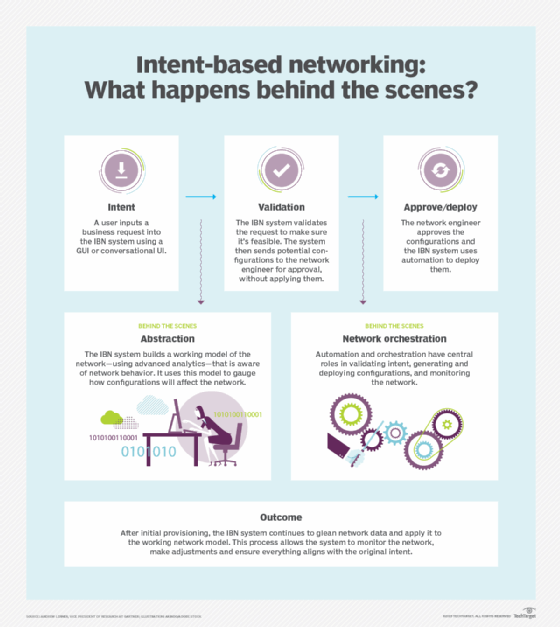intent-based networking (IBN)
Intent-based networking (IBN) is a form of network administration that incorporates artificial intelligence (AI), network orchestration and machine learning (ML) to automate administrative tasks across a network. The goal of IBN is to reduce the complexity of creating, managing and enforcing network policies and reduce the manual labor associated with traditional configuration management. For example, an IBN command may look like this:
Allow accounting applications to access server ABC, but do not allow manufacturing applications to access.
The IBN management application will then determine which devices and routes match the business intention and make the appropriate configuration changes automatically.
Intent-based networking and software-defined networking (SDN) are similar in many aspects. Both approaches rely on a centralized controller to manage distributed devices on the network instead of individually managing each device from its own management console. Both approaches have the ability to understand network configuration and interaction across multiple devices.
Where the two approaches differ, however, is in how they are addressed at the administrator level. SDN continues to have a device-centric view of the network and commands are primarily about how devices should operate, but intent-based networking commands are issued from a business perspective. This second-level abstraction is the primary difference when it comes to intent-based networking vs. SDN.

Characteristics of IBN
Every intent-based networking system (IBNS) incorporates the following four aspects:
- Translation and validation: The system can translate a given command or business intent into actions that the software can perform. Additionally, it verifies that the intent can be executed successfully in the first place.
- Automated implementation: Once the intent or desired state is defined, the system will allocate network resources and enforce policies to meet the goal.
- State awareness: The system will continuously gather and monitor data to reflect the current state of the network.
- Assurance and dynamic optimization/remediation: Using machine learning, the system will implement and maintain the desired state of the network, applying automated corrective action if necessary. ML gives the network the ability to analyze, extract and learn from data dynamically.
Benefits of IBN
A few benefits of intent-based networking include:
- Reduces the complexity of the management and maintenance of network policies.
- Simplifies the deployment of additional network services.
- Reduces labor associated with
traditional configuration of switches and routers. - Strengthens network security capabilities.
- Improves agility of the entire network system.
- Eliminates repetitive or error-prone coding associated with manual inputs.
IBN vs. SDN
While IBN and software-defined networking has similar goals, intent-based networking adds more abstraction and automation of manual processes. SDN moves the focus of network infrastructure from hardware and configurations to software and policies, allowing for more programmability. IBN takes this strategy to a higher level by incorporating AI and ML to achieve predictability. Ideally, IBN practices will incorporate and build upon SDN components. For example, an IBNS could use an SDN controller to carry out policies.
Importance of intent-based networking
The majority of current networks are managed manually, and administrators create scripts that detail everything required to accomplish a given task through a command line interface (CLI). In contrast, with intent-based networking,
An analogy to IBN could be an autonomous vehicle. The desired outcome would be identified as the destination address and input into the system. From that point forward, the vehicle would define the subsequent tasks that would need to be made in order to achieve that outcome such as traffic maneuvering and GPS monitoring. In essence, a functioning intent-based system would respond, automatically or by request, to a system event without human input.
Most IBN tools and software are offered as a Network-as-a-Service (NaaS) model, meaning it can be managed on multiple devices using one interface. Common vendors with IBN products include
While IBN is still a developing area of technology, Gartner predicts that IBN will be fully functioning in enterprise networks by 2020. According to many industry analysts, IBN will be necessary to manage the networks of the future connecting data centers, public clouds and the internet of things (IoT).